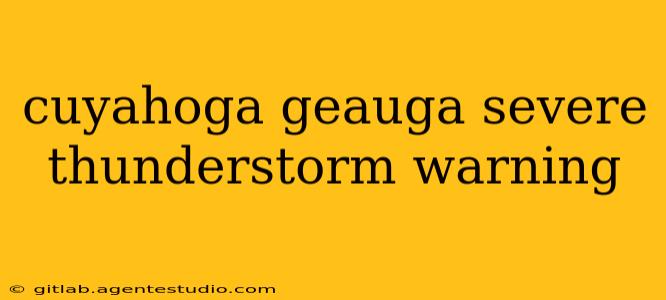Severe thunderstorm warnings for Cuyahoga and Geauga counties in Ohio are not uncommon, especially during the spring and summer months. Understanding the risks and knowing how to prepare and react is crucial for staying safe. This guide will provide essential information on severe thunderstorm safety, specific to these two Ohio counties.
Understanding the Threat: Severe Thunderstorms in Cuyahoga and Geauga Counties
Cuyahoga and Geauga counties, situated in northeastern Ohio, are susceptible to severe thunderstorms due to their location within the Great Lakes region. These storms can bring a range of hazardous weather conditions, including:
- High Winds: Gusts exceeding 58 mph can damage trees, power lines, and structures.
- Large Hail: Hailstones larger than an inch in diameter can cause significant property damage and injury.
- Torrential Rainfall: Heavy downpours can lead to flash flooding, especially in low-lying areas and urban environments.
- Tornadoes: While less frequent than other severe weather phenomena, tornadoes are a possibility and can be incredibly destructive.
The National Weather Service (NWS) issues severe thunderstorm warnings when these hazardous conditions are imminent or occurring. Paying close attention to weather alerts is paramount.
Preparing for a Severe Thunderstorm Warning
Proactive preparation is key to minimizing risks during severe thunderstorms. Here's a checklist for Cuyahoga and Geauga county residents:
Before the Storm:
- Develop an Emergency Plan: Designate a safe room in your home, preferably a basement or interior room on the lowest level. Know your evacuation routes and have a meeting place established for your family.
- Gather Supplies: Keep a readily accessible emergency kit containing flashlights, batteries, bottled water, non-perishable food, a first-aid kit, and any necessary medications.
- Trim Trees and Secure Loose Objects: Remove any dead or damaged branches that could fall during high winds. Secure outdoor furniture, trash cans, and other loose items that could become projectiles.
- Charge Electronics: Ensure your cell phones, laptops, and other devices are fully charged. Consider having a portable power bank available.
- Monitor Weather: Regularly check weather forecasts and warnings from the NWS via radio, television, or weather apps.
During the Storm:
- Seek Shelter Immediately: When a severe thunderstorm warning is issued for your area, move to your designated safe room immediately. Stay away from windows and doors.
- Unplug Electronics: To avoid damage from lightning strikes, unplug electronic devices and appliances.
- Stay Informed: Continue to monitor weather updates throughout the storm.
- Avoid Driving: If possible, avoid driving during a severe thunderstorm. Flash floods and downed power lines pose significant dangers.
- Stay Away from Water: Never attempt to cross flooded areas on foot or in a vehicle.
After the Storm:
- Assess Damage: Once the storm has passed, carefully assess your property for damage.
- Report Downed Power Lines: Contact your local utility company immediately to report any downed power lines.
- Avoid Floodwaters: Floodwaters can be contaminated and may contain dangerous debris. Stay away from flooded areas.
- Seek Assistance: If you require assistance, contact local emergency services.
Specific Considerations for Cuyahoga and Geauga Counties
Both counties have diverse terrain, including urban areas, suburban neighborhoods, and more rural landscapes. Flash flooding is a particular concern in areas with poor drainage. Residents living near rivers and streams should be especially vigilant during periods of heavy rainfall.
Conclusion: Staying Safe is Paramount
Severe thunderstorms pose a significant threat to Cuyahoga and Geauga counties. By understanding the risks, preparing adequately, and taking appropriate action during and after a severe thunderstorm warning, residents can significantly reduce their risk and ensure their safety. Remember, your safety is paramount – prioritize preparedness and heed all official weather warnings.

